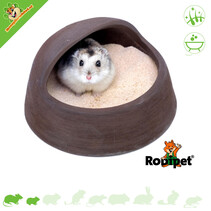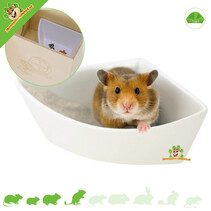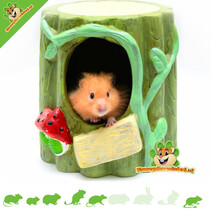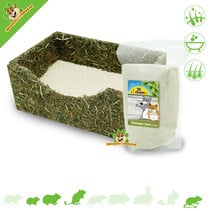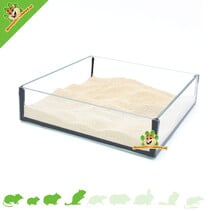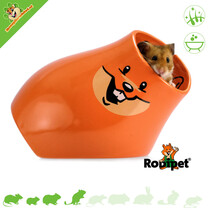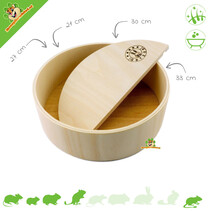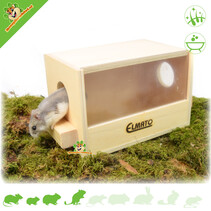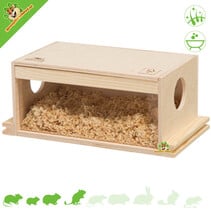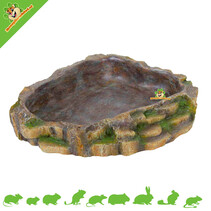Hamster & Dwarf Hamster Sand & Sand Bath – Healthy Coat and Hygiene for your Hamster
- Ordered before 5 p.m., shipped the same day!
- Al 14 jaar een begrip!
- Delivery from our own stock
- Ordered before 5 p.m., shipped the same day!
- Al 14 jaar een begrip!
- Delivery from our own stock
Buy a sand bath for your Hamster or Dwarf Hamster easily and quickly at DRD Rodent Shop ® The Hamster Webshop for your Hamster!
 When it comes to grooming, a sandbox is recommended. The animals love to roll in the sand and clean their coats. The sand has an abrasive and degreasing effect. In the summer, it even provides a little cooling thanks to its degreasing properties.
When it comes to grooming, a sandbox is recommended. The animals love to roll in the sand and clean their coats. The sand has an abrasive and degreasing effect. In the summer, it even provides a little cooling thanks to its degreasing properties.
Attention! Never use shell sand in the sandbox. This sand is too sharp for the hamster's skin.
Do Hamsters & Dwarf Hamsters Need a Sand Bath?
In the wild, animals use sand as needed. The Syrian hamster lives mainly in sandy desert areas and therefore uses sand all year round for its night display. The Roborovski Dwarf hamster also needs sand because it naturally comes from desert areas. The other dwarf hamster species such as the Russian Dwarf hamster, the Campbell's Dwarf hamster and the Chinese Dwarf hamster, like to use a sand bath when they need it.
What is the use of a sand bath for my hamster?
A sand bath helps your hamster keep its fur clean and healthy. The sand absorbs excess oil and dirt, and it helps your hamster maintain its natural grooming behavior.
What kind of sand is best for my hamster?
Use special chinchilla sand , which is soft and safe for your hamster. Avoid shell sand or sand from outside, from the garden, as these may contain chemicals that can be harmful.
Why use Chinchilla sand?
We call it Chinchilla sand, but the sand is actually suitable for all small rodents that like to bathe. Chinchilla sand is a clay-based sand type, which means that this sand is most suitable for the natural habitat of the animals. The sand has a drying effect and that is also very important to be able to degrease the coat. Animals that do not naturally have a greasy coat will bathe less often in the sand.
In the wild, hamsters can only make tunnels in soils that contain clay, even if only a little. In this way, tunnels remain standing. The dried-out surface clay soils are used by the animals as a sand bath.
Why do Hamsters and Dwarf Hamsters bathe in sand?
Hamsters and Dwarf hamsters bathe in sand in the wild to keep their fur clean and free of grease, but also to get rid of parasites, for example. Sand is also good for itching, because it has an abrasive effect. In addition, sand ensures that the fur is degreased and therefore becomes more separated, which in turn ensures good ventilation and optimum humidity between the fur. The latter also prevents mold formation. Animals that really need a sand bath, such as Gerbils, for example, can develop skin fungus if there is no sand bath.
How often should my hamster take a sand bath?
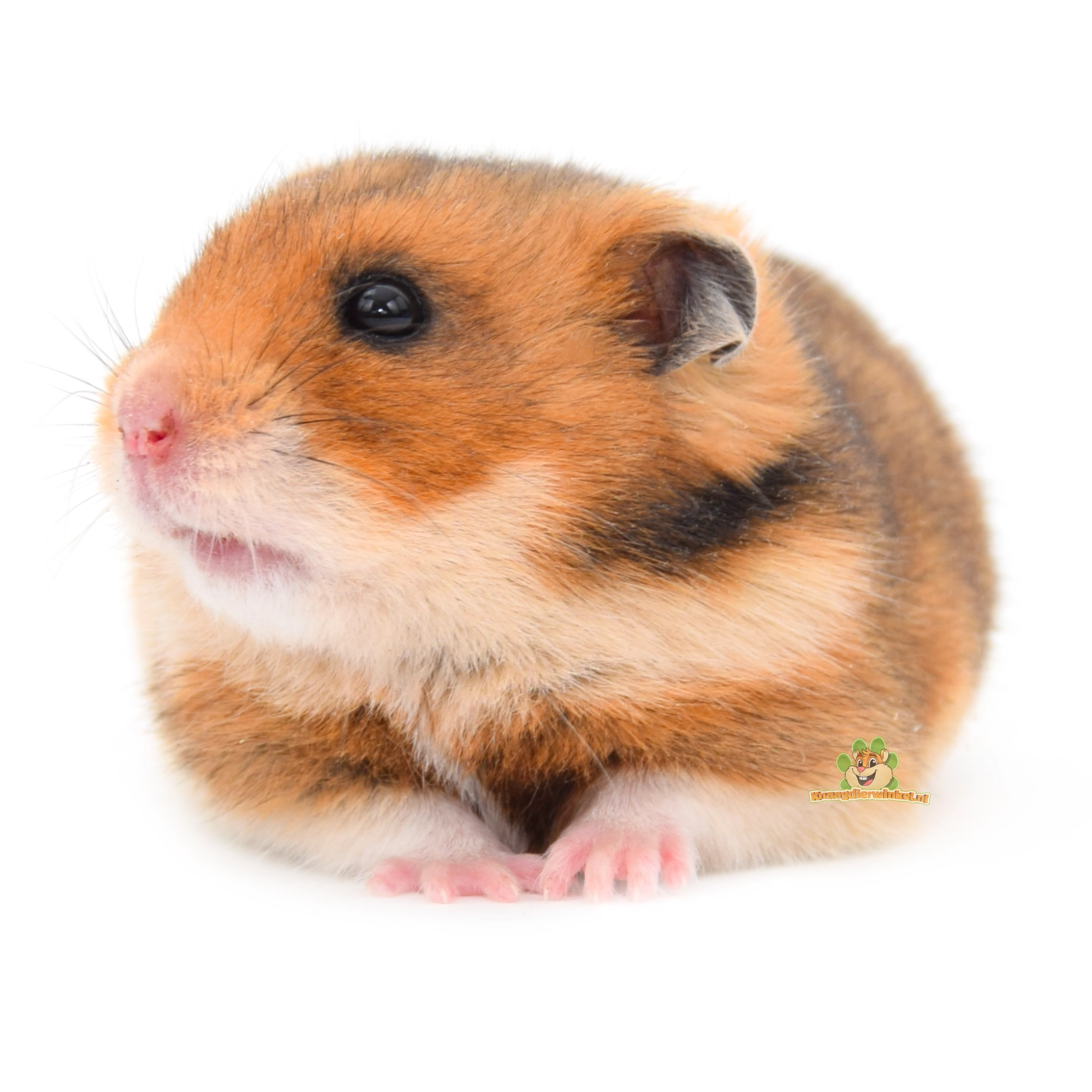 Your hamster can take a sand bath daily, but this depends on his needs and preferences. Some hamsters enjoy a sand bath, while others use it less often. Make sure you always have fresh sand available.
Your hamster can take a sand bath daily, but this depends on his needs and preferences. Some hamsters enjoy a sand bath, while others use it less often. Make sure you always have fresh sand available.
How do I place a sand bath in the cage?
Place a sand bath with a layer of sand in your hamster cage. Make sure the bowl is large enough for your hamster to turn around and dig completely. Place it in a corner of the cage to minimize clutter.
What is the difference between hamster sand/chinchilla sand and regular sand?
Hamster sand or chinchilla sand is specially designed for small animals such as hamsters, gerbils, degus and chinchillas. It is finely ground, gentle on the skin and fur and contains no harmful substances. Regular sand can contain contaminants that are harmful to your hamster.
Can I also use a sand bath for my dwarf hamster?
Yes, sand baths are suitable for dwarf hamsters , just like other hamster species. Make sure the bowl offers enough space and the sand is always clean. Avoid too much sand in the cage, because it can cause a mess.
How do I clean the sand bath?
Clean the sand bath at least once a week. Remove the used sand and replace it with fresh, clean sand. Make sure to clean the container itself to prevent bacteria. You can also use a sieve scoop to clean your hamster's sand.
How much sand should I put in the sand bath?
A layer of about 2-3 cm is usually enough for your hamster to roll and dig. Make sure it is not too deep, so your hamster cannot drown in it.
Why is my hamster not interested in the sand bath?
Not all hamsters like a sand bath. Your hamster may not accept it right away. Try placing the sand bath in different places in the cage or use odorless, finely ground sand that will attract his interest.
Is it safe for my hamster to sleep in a sand bath?
Although some hamsters use a sand bath as a sleeping place, it is important that your hamster always has access to a clean, comfortable bed such as hay or dust-free paper. The sand bath is for hygiene and grooming, not for sleeping.






